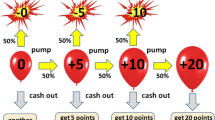Abstract
Nowadays financial products are extremely complex and the decision to choose among them could represent a stressful event for individuals. Information related to the risk/return profile of an investment instrument and the way it is represented (framing effect) are crucial in determining the outcome of individuals’ decisions. In this paper we consider two schemes that can be employed to represent the random performances of risky financial products, namely the what if and probabilistic scenarios frames. This paper aims at measuring the impact of the two above mentioned schemes on investors’ decision accuracy and peripheral nervous system activity. In particular, the goal is twofold: (1) to investigate the behavioural and physiological indexes elicited in the decision-making process of investors who have to choose on the basis of the two different schemes; (2) to investigate on the effect of time pressure when probabilistic scenarios or what if frames are used. The first point is investigated by means of a decision making task, while the second one by means of a perceptual one.







Similar content being viewed by others
References
Baradell, J. G., & Klein, K. (1993). Relationship of life stress and body consciousness to hypervigilant decision making. Journal of Personality and Social Psychology, 64, 267–273.
Barr, D. J., Levy, R., Scheepers, C., & Tily, H. J. (2013). Random effects structure for confirmatory hypothesis testing: Keep it maximal. Journal of Memory and Language, 68, 255–278.
Bates, D., Maechler, M., Bolker, B., & Walker, S. (2015). Fitting linear mixed-effects models using lme4. Journal of Statistical Software, 67, 1–48.
Benedek, M., & Kaernbach, C. (2010). A continuous measure of phasic electrodermal activity. Journal of Neuroscience Methods, 190, 80–91.
Bertrand, M., Mullainathan, S., Karlan, D., Shafir, E., & Zinman, J. (2010). What’s advertising content worth? Evidence from a consumer credit marketing field experiment. Quarterly Journal of Economics, 125, 263–306.
Castellano, R., & Cerqueti, R. (2013). Roots and effects of financial misperception in a stochastic dominance framework. Quality & Quantity, 47, 3371–3389.
Castellano, R., & Cerqueti, R. (2016). A theory of misperception in a stochastic dominance framework and its application to structured financial products. IMA Journal of Management Mathematics, 29, 23–37.
CESR. (2010). Guidelines-Selection and presentation of performance scenarios in the key investor information document (KID) for structured UCITS. CESR/10-1318.
Christopoulos, G. I., Uy, M. A., & Yap, W. J. (2016). The body and the brain: measuring skin conductance responses to understand the emotional experience. Organizational Research Methods, 22, 394–420.
Cox, A. D., Cox, D., & Zimet, G. (2006). Understanding consumer responses to product risk information. Journal of Marketing, 70, 79–91.
Dawson, M. E., Schell, A. M., & Courtney, C. G. (2011). The skin conductance response, anticipation, and decision-making. Journal of Neuroscience, Psychology, and Economics, 4, 111–116.
de Goeij, P., Hogendoorn, T., & Campenhout, G.V. (2014). Pictures are worth a thousand words: Graphical information and investment decision making, Mimeo.
Fischer, G. W. (1989). Prescriptive decision science: Problems and opportunities. Annals of Operations Research, 19, 489–497.
Frydman, C., & Camerer, C. F. (2016). The psychology and neuroscience of financial decision making. Trends in Cognitive Sciences, 20(9), 661–675.
Gray, J. R. (1999). A bias toward short-term thinking in threat-related negative emotional states. Personality and Social Psychology Bulletin, 25, 65–75.
Gupta, A., & Murray, W. (2003). How to spend and invest retirement savings. Annals of Operations Research, 124, 205–224.
Hämäläinen, R. P., Luoma, J., & Saarinen, E. (2013). On the importance of behavioural operational research: The case of understanding and communicating about dynamic systems. European Journal of Operational Research, 228, 623–634.
Hillenbrand, A., & Schmelzer, A. (2017). Beyond information: Disclosure, distracted attention, and investor behavior. Journal of Behavioral and Experimental Finance, 16, 14–21.
Hull, J. C., & White, A. (1990). Pricing interest-rate derivative securities. Review of Financial Studies, 3, 573–592.
Hull, J., & White, A. (1994). Numerical procedures for implementing term structure models I: Single-factor models. Journal of Derivatives, 2, 7–16.
Hull, J., & White, A. (1996). Using Hull–White interest rate trees. Journal of Derivatives, 3, 26–36.
Lajante, M., Droulers, O., Dondaine, T., & Amarantini, D. (2012). Opening the “black box” of electrodermal activity in consumer neuroscience research. Journal of Neuroscience, Psychology, and Economics, 5, 238–249.
Liuzza, M. T., Olofsson, J. K., Sabiniewicz, A., & Sorokowska, A. (2017). Body odor trait disgust sensitivity predicts perception of sweat biosamples. Chemical Senses, 42, 479–486.
Jelić, A., Tieri, G., De Matteis, F., Babiloni, F., & Vecchiato, G. (2016). The enactive approach to architectural experience: A neurophysiological perspective on embodiment, motivation, and affordances. Frontiers in Psychology, 7, 1–20.
Jarrow, R. A., & Turnbull, S. M. (1995). Pricing derivatives on financial securities subject to credit risk. The Journal of Finance, 1, 53–85.
Lusardi, A., & Mitchell, O. (2007). Financial literacy and retirement preparedness. Evidence and implications for financial education. Business Economics, 42, 35–44.
Maier, S. U., Makwana, A. B., & Hare, T. A. (2015). Acute stress impairs self-control in goal-directed choice by altering multiple functional connections within the Brain’s decision circuits. Neuron, 87, 622–632.
Minenna, M. (2011). A quantitative framework to assess the risk-reward profile of non-equity products. London: Risk Books.
Pabst, S., Brand, M., & Wolf, O. T. (2013). Stress and decision making: A few minutes make all the difference. Behavioural Brain Research, 250, 39–45.
Palomaki, J., Kosunen, I., Kuikkaniemi, K., Yamabe, T., & Ravaja, N. (2013). Anticipatory electrodermal activity and decision making in a computer poker-game. Journal of Neuroscience, Psychology, and Economics, 6, 55–70.
Panasiti, M. S., Ponsi, G., Monachesi, B., Lorenzini, L., Panasiti, V., & Aglioti, S. M. (2018). Cognitive load and emotional processing in psoriasis: A thermal imaging study. Experimental Brain Research, 237, 211–222.
Pinheiro, J. C., & Bates, D. M. (2000). Mixed-effects models in S and S-PLUS. New York: Springer.
Ponsi, G., Monachesi, B., Panasiti, V., Aglioti, S. M., & Panasiti, M. S. (2019). Physiological and behavioral reactivity to social exclusion: A functional infrared thermal imaging study in patients with psoriasis. Journal of Neurophysiology, 121, 38–49.
Ponsi, G., Panasiti, M. S., Aglioti, S. M., & Liuzza, M. T. (2017a). Right-wing authoritarianism and stereotype-driven expectations interact in shaping intergroup trust in one-shot versus multiple-round social interactions. PLoS ONE, 12, e0190142.
Ponsi, G., Panasiti, M. S., Rizza, G., & Aglioti, S. M. (2017b). Thermal facial reactivity patterns predict social categorization bias triggered by unconscious and conscious emotional stimuli. Proceedings of the Royal Society B: Biological Sciences, 284, 18–61.
Ponsi, G., Panasiti, M. S., Scandola, M., & Aglioti, S. M. (2016). Influence of warmth and competence on the promotion of safe in-group selection: Stereotype content model and social categorization of faces. The Quarterly Journal of Experimental Psychology, 69, 1464–1479.
Porcelli, A. J., & Delgado, M. R. (2009). Acute stress modulates risk taking in financial decision making. Psychological Science, 20, 278–283.
Porcelli, A. J., & Delgado, M. R. (2017). Stress and decision making: effects on valuation, learning, and risk-taking. Current Opinion in Behavioral Sciences, 14, 33–39.
Rizzi, S. (2016). What-if analysis. In L. Liu & T. Özsu (Eds.), Encyclopedia of database systems (2nd ed.). New York: Springer.
Starcke, K., & Brand, M. (2012). Decision making under stress: A selective review. Neuroscience and Biobehavioral Reviews, 36, 1228–1248.
Tieri, G., Morone, G., Paolucci, S., & Iosa, M. (2018). Virtual reality in cognitive and motor rehabilitation: Facts, fiction and fallacies. Expert Review of Medical Devices, 15, 107–117.
Tieri, G., Tidoni, E., Pavone, E. F., & Aglioti, S. M. (2015). Body visual discontinuity affects feeling of ownership and skin conductance responses. Scientific Reports, 5, 1–8.
Tversky, A., & Kahneman, D. (1986). Rational choice and the framing of decisions. The Journal of Business, 59, 251–278.
Vecchiato, G., Jelic, A., Tieri, G., Maglione, A. G., De Matteis, F., & Babiloni, F. (2015a). Neurophysiological correlates of embodiment and motivational factors during the perception of virtual architectural environments. Cognitive Processing, 16, 425–429.
Vecchiato, G., Tieri, G., Jelic, A., Maglione, A. G., De Matteis, F., & Babiloni, F. (2015b). Electroencephalographic correlates of sensorimotor integration and embodiment during the appreciation of virtual architectural environments. Frontiers in Neuroscience, 16, 425–429.
Vlaev, I., Stewart, N., & Chater, N. (2008). Risk preference discrepancy: A prospect relativity account of the discrepancy between risk preferences in laboratory gambles and real world investments. Journal of Behavioral Finance, 9, 132–148.
Wang, A. (2009). Interplay of investors’ financial knowledge and risk taking. Journal of Behavioral Finance, 10, 204–213.
Yu, R. (2016). Stress potentiates decision biases: A stress induced deliberation-to-intuition (SIDI) model. Neurobiology of Stress, 3, 83–95.
Author information
Authors and Affiliations
Corresponding author
Additional information
Publisher's Note
Springer Nature remains neutral with regard to jurisdictional claims in published maps and institutional affiliations.
Rights and permissions
About this article
Cite this article
Castellano, R., Mancinelli, M., Ponsi, G. et al. What if versus probabilistic scenarios: a neuroscientific analysis. Ann Oper Res 299, 331–347 (2021). https://doi.org/10.1007/s10479-019-03272-5
Published:
Issue Date:
DOI: https://doi.org/10.1007/s10479-019-03272-5




